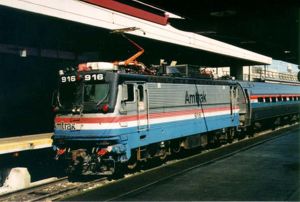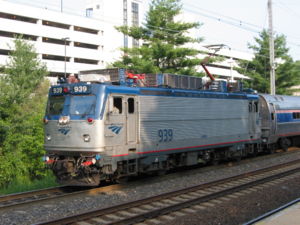EMD AEM-7
 AEM-7 916 at Union Station, Washington, D.C. | |
| Power type | Electric |
|---|---|
| Designer | Allmänna Svenska Elektriska Aktiebolaget (ASEA) |
| Builder | General Motors Electro-Motive Division |
| Build date | 1978 – 1988 |
| Total production | 65 |
| AAR wheel arr. | B-B |
| Gauge | 4 ft 8½ in (1435 mm) |
| Length | 51 ft (15.54 m) |
| Total weight | 101 tons (202,000 lb, 91,708 kg) |
| Electric system | 11,000 V AC, 25 Hz 11,000-13,500 V AC, 60 Hz 25,000 V AC, 60 Hz |
| Collection method | Overhead AC with dual pantographs |
| Top speed | 125 mph (201 km/h) for Metroliner and Regional 90 mph (145 km/h) for long-distance trains |
| Power output | 7,000 hp (5.2 MW) |
| Career | Amtrak, MARC and SEPTA |
| Number | AMT 901-902, 904-912, 914-953; MARC 4900-4903; SEPTA 2301-2307 |
| Nicknames | Toasters; Swedish Meatballs; Mighty Mouse |
| Locale | Amtrak's Northeast Corridor between Boston and Washington, DC |
The AEM-7 is a B-B electric locomotive running on the Northeast Corridor of the United States between Washington DC and Boston. They were built by General Motors Electro-Motive Division from 1978 to 1988. In the Boston Mechanical Department of Amtrak they are known as "Meatballs" and the Washington Mechanical Department they are knowns as ASEAs since some of their major parts and components were designed in Sweden by ASEA (Allmänna Svenska Elektriska Aktiebolaget), which was merged with ABB (Asea Brown Boveri) in 1988. They are also affectionately known as "toasters," owing to their boxy shape.
History
After the apparent lack of success of the GE E60 electric locomotives in the mid-1970s, Amtrak began to look for a successor to the famous Pennsylvania Railroad GG1 electric locomotive. Existing European designs (with proven reliability) were considered. Two European locomotives were brought over for a series of trials in 1977. One is a French CC 21000 class given number X996,[1] and the other is a Swedish Rc4, X995.[2] Amtrak favored the Swedish design, which became the base for the AEM-7. Amtrak first ordered 30 AEM-7s in 1977 (Order Number: 776073), then ordered additional 17 AEM-7s in 1980 (Order Number: 806004).[3]
By 1978 General Motors Electro-Motive Division (EMD) began production. The bodies came from the Budd Company, with electrical, trucks and mechanical parts imported from Sweden. The first AEM-7 (900) was delivered to Amtrak and went into service in 1979.
Between 1980 and 1982, 46 AEM-7s (901-946) went into service. This helped retire the last GG1s from regular service. Amtrak ordered seven more AEM-7s in 1987 (Order Number: 876006), which were completed by 1988.
The AEM-7 weighs only 101 tons, whereas the GG1 weighs 238 tons. With all the weight on eight drivers, the AEM-7 has the highest horsepower to weight ratio (70 hp/ton) ever, coupled with a sophisticated wheelslip control (Pressductor) system.
On January 4, 1987, locomotives 900 and 903 were destroyed in a fatal collision with a Conrail freight train in Maryland. Locomotive 913 was heavily damaged by fire in November 2000 and then removed from the active roster in February 2003. Locomotive 930 was damaged by fire on June 29, 2003 at Elkton, MD. On July 8, 2003, locomotive 922 was also seriously damaged by fire.
Currently there are 51 AEM-7s on the Amtrak roster, numbers 901 through 953 except 903 and 913. In addition to Amtrak, MARC and SEPTA also operate AEM-7s in commuter service, with 4 and 7 units respectively. The MARC units (4900-03) were built in 1986, and the SEPTA units (2301-07) were built in 1987. In October, 2006, Amtrak, due to the upgrade of the Keystone Corridor between Harrisburg and Philadelphia, started running electrified "push-pull" service on its Keystone trains, with the AEM-7 "trailing" eastbound and "leading" westbound. All AEM-7s on the Northeast Corridor, regardless of direction, lead their trains (no push-pull operation).
AEM-7AC
In 1999, Amtrak and Alstom began a remanufacturing program for Amtrak AEM-7s. Alstom supplied AC propulsion equipment, electrical cabinets, transformers, head-end power (HEP), and cab displays so that they have AC traction motors, improved propulsion and enriched torque. Amtrak workers performed the overhauls under Alstom supervision at Amtrak's shop in Wilmington, Delaware.[4]
The power modules use water-cooled IGBT technology and provide 5 MW of traction power plus 1 MW of HEP, enough for 12 coaches. As such, the remanufactured AEM-7 is the world's first passenger locomotive with IGBT in service.
Also, the cab of the remanufactured AEM-7 is also upgraded. This was accomplished by adding two screens, one of which displays main functions and verifies operations; the other, failures and their location to improve locomotive availability.
These remanufactured AEM-7s are designated as "AEM-7AC". Because of lack of funding, the AEM-7AC project ended in October 2002. Between 1999 and 2002, 29 AEM-7s were converted to AEM-7ACs. 5 AEM-7ACs, 916, 918, 924, 901 and 905 (in chronological order), went under overhauls in FY 2006.[5]
To tell an AEM-7AC from an AEM-7, the easiest way is to see the appearance on the roof. All AEM-7ACs have their resistors scattered around the roof. Their air filters are located on the middle of the roof, where the resistors used to be. Smaller air conditioners are used at each end to make room for scattered resistors on the roof. For AEM-7ACs 916, 918, 924, 901 and 905 prior to their FY 2006 overhauls, their air filters were located around the sides of pantographs and like their DC counterparts, the resistors were on the middle of the roof.
Moreover, all AEM-7ACs except 916 are equipped with "electronic"-sound-like bells, while all AEM-7s and AEM-7AC 916 retain their original bells.
The 29 AEM-7ACs are 901, 904, 905, 908, 914, 916-921, 923-925, 927-929, 934-936, 938-944, 946 and 948.
ALP-44: Variant of the AEM-7
The ALP-44 is an electric locomotive built by Asea Brown Boveri (Sweden) between 1990 and 1996. It was designed specifically for New Jersey Transit. At first glance, the two locomotives might look the same to a casual observer. Both the ALP-44 and AEM-7 are based on the same line of locomotives from ABB; the AEM-7 from the Rc4, and the ALP-44 from the Rc6 and Rc7 models.
ABB provided one ALP-44 to SEPTA in part settlement of claims for late delivery of the N-5 Norristown High Speed Line cars. The engine (numbered 2308) operates interchangeably with SEPTA's AEM-7 fleet.
References and notes
- ↑ Amtrak's X996. Retrieved on 2006-09-08.
- ↑ Bengt Muten. The original Swedish meatball - SJ Rc4 testing as Amtrak X995. Retrieved on 2006-09-08.
- ↑ EMD electric order numbers. Retrieved on 2006-09-08.
- ↑ New life for an old workhorse, Railway Age, May 2000
- ↑ Mechanical goals advance toward a state of good repair. Destination: Freedom Newsletter (2006-05-08).
External links
- AEM-7 Photos at Railpictures.net and RR Picture Archives
- AEM-7AC Completion Dates and Data by On Track On Line
- Amtrak Locomotive and Car Notes
- Current Status of AEM-7s
- Amtrak Photo Archives
- Amtrak Electrics by Kenneth Arnerstedt
Limited production and export locomotives built by EMD | |
|---|---|
| Electrics | SW1200MG · AEM-7 · GM6 · GM10 · GF6C |
| Industrial, military, export and narrow gauge | Model 40 · DDM45 · DHI · GMDH-1 · GMDH-3 · MRS-1 · GA8 · G8 · G12 · G16 · G26 · NF110 · NF210 · JT42CWR (Series 66) · JT42HW-HS · GT46MAC · GT22HW · GT46PAC |
| Streamliners | M-10000 · M-10001 · M-10002 · M-10003-6 · Pioneer Zephyr · General Pershing Zephyr · Green Diamond · Flying Yankee · Aerotrain |
| Experimentals | 1800 hp B-B |
| See also: List of EMD locomotives | |

